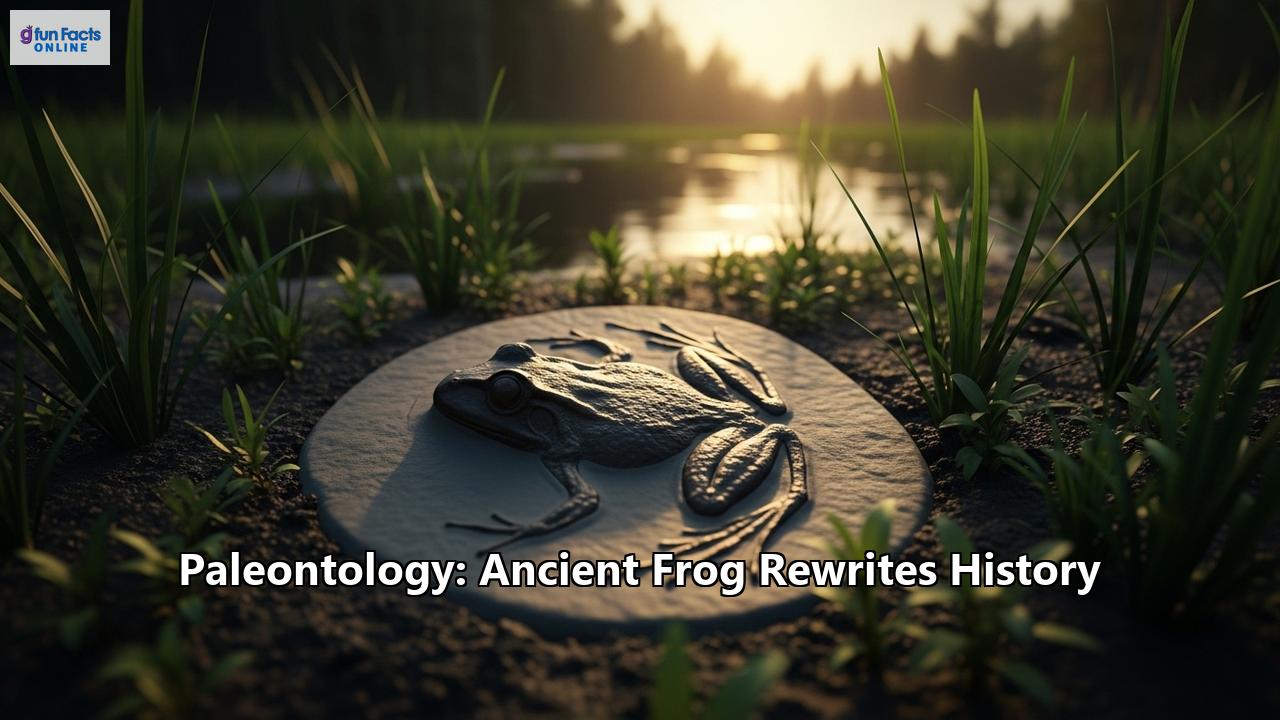A Leap Through Time: How Ancient Frogs Are Reshaping History
In the quiet corners of the globe, from the sunburnt landscapes of Australia to the frozen expanses of Antarctica, paleontologists are uncovering fossilized secrets that are dramatically reshaping our understanding of life on Earth. These are not the colossal bones of dinosaurs, but the delicate remains of ancient frogs. These tiny amphibians, long-overlooked protagonists in the story of evolution, are now hopping into the spotlight, bringing with them tales that rewrite timelines, redraw continents, and offer vital clues for the future of their modern-day kin.
An Australian Discovery Leaps Back 30 Million Years
In southeastern Queensland, Australia, a groundbreaking discovery has sent ripples through the scientific community. On the traditional lands of the Waka Waka people, paleontologists from the University of New South Wales unearthed the 55-million-year-old fossilized pelvic bones of a previously unknown tree frog. Named Litoria tylerantiqua, this ancient amphibian has single-handedly pushed back the known history of Australian tree frogs by an astonishing 30 million years.
For years, molecular clock studies—a method of dating evolutionary divergence based on genetic mutations—suggested that Australian and South American tree frogs parted ways on the evolutionary tree about 33 million years ago. Previous fossil finds seemed to support this, with the oldest known Australian tree frog fossils dating to around 26 million years ago. The Murgon fossil site, however, tells a different story. The existence of Litoria tylerantiqua provides concrete evidence that these frogs were established in Australia far earlier than ever imagined. As the study's lead author, Dr. Roy Farman, asserts, the previous timeline was "at least 22 million years too young."
This ancient frog lived during the Eocene epoch, a period when Australia, Antarctica, and South America were the last remaining pieces of the southern supercontinent, Gondwana. The global climate was warmer, and lush, forested corridors are believed to have connected South America and Australia, creating a pathway for fauna to disperse. The discovery of Litoria tylerantiqua, named in honor of the pioneering Australian frog researcher Michael Tyler, confirms that its ancestors had already made this journey, offering a new chapter in the story of Gondwana's breakup.
Antarctica's "Living Fossil" and a Lost World
Thousands of miles away, another extraordinary find has emerged from the icy grip of Antarctica. On Seymour Island, near the Antarctic Peninsula, researchers discovered the 40-million-year-old fossilized remains of a "helmeted frog" belonging to the Calyptocephalellidae family. This marked the first time a modern amphibian fossil had ever been found on the continent.
The closest living relative of this ancient creature is the Chilean helmeted water toad, Calyptocephalella gayi, a robust frog that inhabits the freshwater ecosystems of Chile. Its ancient cousin’s presence in Antarctica is a testament to the continent's once-temperate past. During the Eocene, Antarctica was not a desolate, frozen landscape but a vibrant world of forests and rivers, with a climate akin to the modern Valdivian rainforests of Chile.
The discovery of Calyptocephalella in Antarctica, alongside its known fossil record in South America, strengthens the narrative of a shared history across the southern continents. These frogs once thrived in a much warmer and interconnected Gondwana, hopping across landscapes that are now separated by vast oceans. Interestingly, Calyptocephalella gayi is itself considered a "living fossil" and is currently facing threats of extinction from habitat loss and human activity, making its ancient lineage a story of both incredible survival and modern-day fragility.
Gondwana's Great Dispersal: Frogs as Storytellers
Because amphibians are generally unable to cross saltwater barriers, their distribution across the globe serves as a powerful indicator of ancient land connections. The discoveries of Litoria tylerantiqua in Australia and Calyptocephalella in Antarctica provide crucial data points that help paleontologists piece together the puzzle of Gondwana's fragmentation.
These fossils support the theory that the ancestors of Australian tree frogs likely journeyed from South America across a then ice-free Antarctica before arriving in Australia. This complex dispersal narrative, driven by the slow dance of continental drift, is now coming into sharper focus, thanks in large part to these ancient amphibian storytellers.
Echoes of the Past: Lessons for Modern Conservation
The significance of these ancient frogs extends far beyond rewriting history books. With a lineage stretching back over 250 million years, frogs have survived multiple mass extinctions, including the cataclysm that eradicated the non-avian dinosaurs. Their fossil record is a unique chronicle of resilience, offering invaluable insights into how life adapts to profound environmental change.
This historical perspective is more critical than ever, as amphibians worldwide face an unprecedented extinction crisis due to habitat loss, climate change, and the rapid spread of diseases like the deadly chytrid fungus. Scientists now believe that by studying how ancient frogs survived past challenges, we can devise more effective strategies to protect their modern descendants.
For example, the knowledge that ancient frogs thrived in habitats vastly different from those of their modern relatives could inform conservation efforts such as translocation—the process of moving threatened species to more secure environments. As Dr. Farman explains, "the fossil record could reveal how some frog groups overcame previous challenges, perhaps by adapting to new, less-threatening habitats. This could provide clues about how we might be able to help."
The discoveries of Litoria tylerantiqua and the Antarctic helmeted frog are powerful reminders that even the smallest creatures can have a monumental impact on our understanding of the planet's history. They are not merely fossils; they are messengers from a lost world, carrying lessons of survival and adaptation that are more relevant today than ever. Their ancient voices, silent for millions of years, now offer a call to action—to listen to the stories of the past in order to protect the biodiversity of the future.
Reference:
- https://scitechdaily.com/55-million-year-old-frog-fossil-rewrites-australian-evolutionary-history/
- https://cosmosmagazine.com/history/palaeontology/australia-earliest-tree-frog/
- https://www.rathbiotaclan.com/22-million-year-old-tree-frog
- https://www.unsw.edu.au/newsroom/news/2025/05/australias-oldest-prehistoric-tree-frog
- https://impactful.ninja/55-million-year-old-frog-fossil-rewrites-australias-evolutionary-timeline/
- https://www.earth.com/news/fossil-discovery-pushes-tree-frog-origins-back-55-million-years/
- https://reptilesmagazine.com/first-frog-fossil-from-antarctica-discovered/
- https://en.wikipedia.org/wiki/Calyptocephalella
- https://scitechdaily.com/old-science-new-twists-ancient-frog-fossils-disrupt-100-year-old-beliefs/
- https://www.ancientodysseys.com/post/top-paleontology-finds-of-2022
- https://amphibiaweb.org/cgi-bin/amphib_query?rel-genus=equals&where-genus=Calyptocephalella
- https://www.researchgate.net/publication/363139867_A_new_fossil_species_of_Calyptocephalella_Anura_Australobatrachia_from_the_Miocene_of_northern_Patagonia_Novel_evidence_of_the_broad_past_diversity_of_the_genus
- https://www.researchgate.net/publication/340871215_First_fossil_frog_from_Antarctica_implications_for_Eocene_high_latitude_climate_conditions_and_Gondwanan_cosmopolitanism_of_Australobatrachia
- https://www.sciencedaily.com/releases/2008/02/080218172307.htm
- https://www.discovermagazine.com/the-sciences/fossils-show-that-these-ancient-frog-families-split-apart-at-least-55
- https://www.biorxiv.org/content/10.1101/2023.05.03.539251v1.full-text
- https://pmc.ncbi.nlm.nih.gov/articles/PMC7232768/

